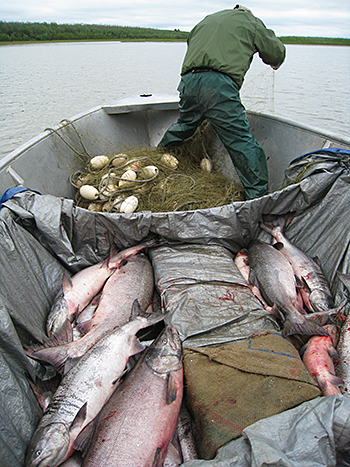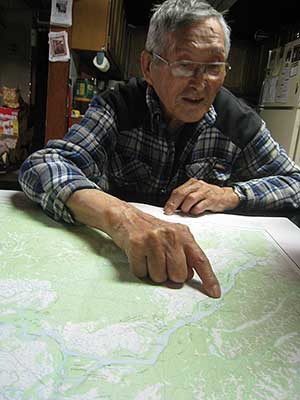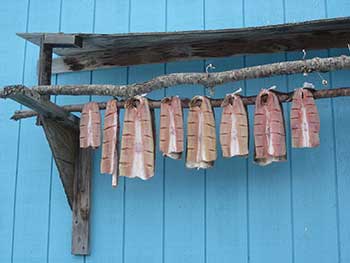Alaska Fish & Wildlife News
February 2014
Documenting the Harvest of Alaska’s Wild Food:
ADF&G’s Division of Subsistence

This is the second installment of a two-part article concerning the responsibilities and services of the ADF&G Division of Subsistence. In the first installment we learned that the mission of the Division of Subsistence is to scientifically quantify, evaluate, and report information about customary and traditional uses of Alaska’s fish and wildlife resources. Our mission statement rests on two core services:
- Research, quantify, and provide the resulting information to the public about customary and traditional uses by Alaskans of fish and wildlife resources.
- Provide scientifically-based information for fisheries and wildlife management programs; and to Board of Fisheries (BOF) and Board of Game (BOG) for their use in evaluating reasonable opportunities for customary and traditional uses.
In order to provide these services the Division assembles subsistence information including historical research and contemporary field research such as data collection in the form of household surveys, participant observation in subsistence activities, ethnographies, mapping, and other methods of the social sciences; analyzes all data collected; and provides reports of the results. The results provide data needs for proposals put before the Alaska BOF and BOG, for specific agency permitting and development needs, and for species and topic specific research projects to address community subsistence concerns.
Technical Paper Series
Results of all Division projects are available to the general public in the form of technical papers. Some technical papers concern specific fish and wildlife management and policy issues. Others provide detailed, basic information on the subsistence fishing, hunting, and gathering patterns of communities, while others summarize years of subsistence harvest data for resources such as salmon, nonsalmon fish, large land mammals, small land mammals, marine mammals, birds and eggs, and vegetation such as berries and greens. Some technical papers report Traditional Ecological (TEK) or Local Traditional Knowledge ( LTK) concerning fish, wildlife, and the changing environment. These studies typically include current and historic mapping of land use areas, descriptions of the social organization of subsistence activities; data about the cash sector of the local economy, distribution and exchange of wild foods; descriptions of the seasonal round of subsistence activities; residents’ observations about fish and wildlife populations and changes to the environment over time. All technical papers can be accessed at the ADF&G website www.subsistence.adfg.state.ak.us currently there are over 380 technical papers available in PDF format in the database.
Northern Region Projects

In the first installment of this article the legislative mandate of the Subsistence Division was discussed, a brief overview of the Subsistence Division was given, and details of one of our major research tools, comprehensive surveys, was explained. Also, the various types of active projects that the Southern Region currently maintains, in particular the Index Community Project, was presented. In this second and final installment, in addition to the above overview of the division’s data reporting methods, the current projects and activities of the Northern Region Program are presented.
The Northern Region Program consists of research projects in the Interior, Arctic, and the Western regions of Alaska. The Northern region’s main office in Fairbanks is staffed by regional manager Jim Simon, 13 Subsistence Resource Specialists (SRSs), two administration staff, five social science technicians, and two interns. The Northern region’s satellite office in Bethel is staffed by one SRS and supported by administration staff in Fairbanks. Currently the northern region maintains a total of 23 active research projects.
The Interior area is currently involved in eight projects. Several of these concern Yukon River salmon. In August 2009, as a result of fishing closures and the effect of the restrictions on the communities in the region, Governor Sean Parnell requested that the U.S. Secretary of Commerce declare the 2009 Yukon River salmon fishery an economic disaster. In response, the Alaska State Legislature requested that the Department of Fish and Game investigate the effects that poor salmon returns had on Yukon River communities. In 2010 and 2011, the Alaska Department of Fish and Game Division of Subsistence designed and implemented the Yukon River Salmon Disaster Project. The primary objective was to study the influence of low Chinook salmon returns on fishing patterns and priorities. Methods of data collection for this project included semi-structured ethnographic interviews and mapping, participant-observation, and short surveys that tracked exchange practices of sharing, barter, and customary trade. As with all division projects participation was voluntary and confidential. Field research included 52 ethnographic interviews with 57 experienced subsistence fishers, or key respondents. Mapping exercises recorded locations of historical and contemporary salmon fishing sites, camps, and fishing gear types used. Researchers also conducted 172 surveys on exchange practices. The report for this project is currently under editorial review.

Other active projects for the Interior area include three additional Yukon Chinook Salmon projects related to the Governor’s Yukon Salmon Research Initiative, and two big game studies: Grayling-Anvik-Shageluk-Holy Cross (GASH) Big Game Project and the Allakaket-Alatna Intensive Management Subsistence Research Project.
The Arctic area of the Northern Region is currently engaged in seven research projects. These include two harvest monitoring programs for northwest key fisheries and for the Western Arctic Caribou Herd, a big game hunting and land use project in the Arctic Refuge, and a study that explores emerging subsistence salmon fisheries in Point Wainwright and Point Lay. The flagship project for the Arctic area is the Chukchi Sea and Norton Sound Subsistence Community Observation Network Project. This project seeks to document coastal community environmental information to understand community harvest levels of fish and wildlife resources,
local perceptions on environmental changes, and community subsistence resource and land use patterns. In addition to standard comprehensive household surveys and interviews with key respondents, and in light of Arctic warming, this project will include local and traditional knowledge (LTK) concerning ecosystem change over time. A major objective is to collect local observations of environmental change, including species population dynamics, health, seasonal geographic distribution, and invasive species. This is a collaborative project between the Division of Subsistence and the tribal governments of nine participating study communities within the North Slope Borough, Northwest Arctic Borough, and Norton Sound region, including Noorvik, Point Lay, Golovin, Diomede, Wainwright, Stebbins, Deering, Point Hope, and Shaktoolik.

The Western area staff is currently conducting research for eight projects. Projects include three Kuskokwim River Chinook salmon studies, two Kuskokwim big game studies, and a whitefish study in Nikolai and Lime Village. The flagship project for the Western area is the on-going Donlin Creek Mine Subsistence Research Program now in its fourth year. This project is part of the National Environmental Protection Act (NEPA) process for the proposed Donlin Creek Mine project. The project’s main goal is to provide a snapshot of subsistence today, to document the importance and extent of subsistence on the Kuskokwim and Yukon rivers. This is a massive undertaking in which comprehensive surveys are being conducted in several communities in phases over a four to five year span. To date, research has been conducted in 22 communities on the lower Yukon River, and all portions of the Kuskokwim River. Field research in an additional five communities will soon be underway for the 2014-2015 field seasons. There is a possibility that even more communities will be added in 2015-2016. Information for Phase 1 of this project can be found in Technical Paper No. 365: Subsistence Harvests in 8 Communities in the Central Kuskokwim River Drainage, 2009. Information for Phase 2 can be found in Technical Paper No. 379: Subsistence Harvests in 6 Communities in the Lower and Central Kuskokwim River Drainage, 2010.
The Western area completed field work on another large scale comprehensive survey in 2013, the Bethel Hub Comprehensive Subsistence Harvest Survey. This project, conducted in the largest rural city in northern Alaska, and in collaboration with local organizations, produced over 460 comprehensive surveys and 36 in-depth ethnographic interviews. Northern staff are currently working on data analysis and report writing.
Partnerships

Collaborative effort is essential for the successful completion of projects. The Division of Subsistence strives to achieve agency goals in cooperation with local tribal and city governments, local organizations, government agencies, and non-profit organizations. State, federal and local governments, and other funding agencies help provide funding for research; project partners in the communities help hire and train local researchers; tribal governments and organizations help identify knowledgeable individuals for key respondent interviews; and finally local residents graciously open their homes and give of their time to local and division researchers. Division researchers in turn provide anonymous, confidential, and unbiased results in the form of publically available reports (i.e., Technical Paper Series) and on the online Community Subsistence Information System at http://www.adfg.alaska.gov/sb/CSIS/
Insuring the continuation of “customary and traditional uses” of wild resources for food, clothing, fuel, transportation, construction, art, crafts, sharing, and customary trade not only “takes a village”, it takes a network of agencies and organizations working together to insure that rural families in Alaska who depend on subsistence fishing and hunting continue to have that opportunity . The Division of Subsistence is committed to fulfilling its responsibilities and services to that end.
“When we speak of ‘subsistence’, we don’t just mean using the resource, but using tribal methods and acting out culture and complying with those values, and we do those things because they are a measure of protection for the land and its resources.” – A Venetie hunter
Lisa Slayton is a former public school teacher and National Park Service ranger. She is currently an SRS II with the Subsistence Division in Fairbanks, where she lives with her wife Stacie and a house full of animals.
Subscribe to be notified about new issues
Receive a monthly notice about new issues and articles.
